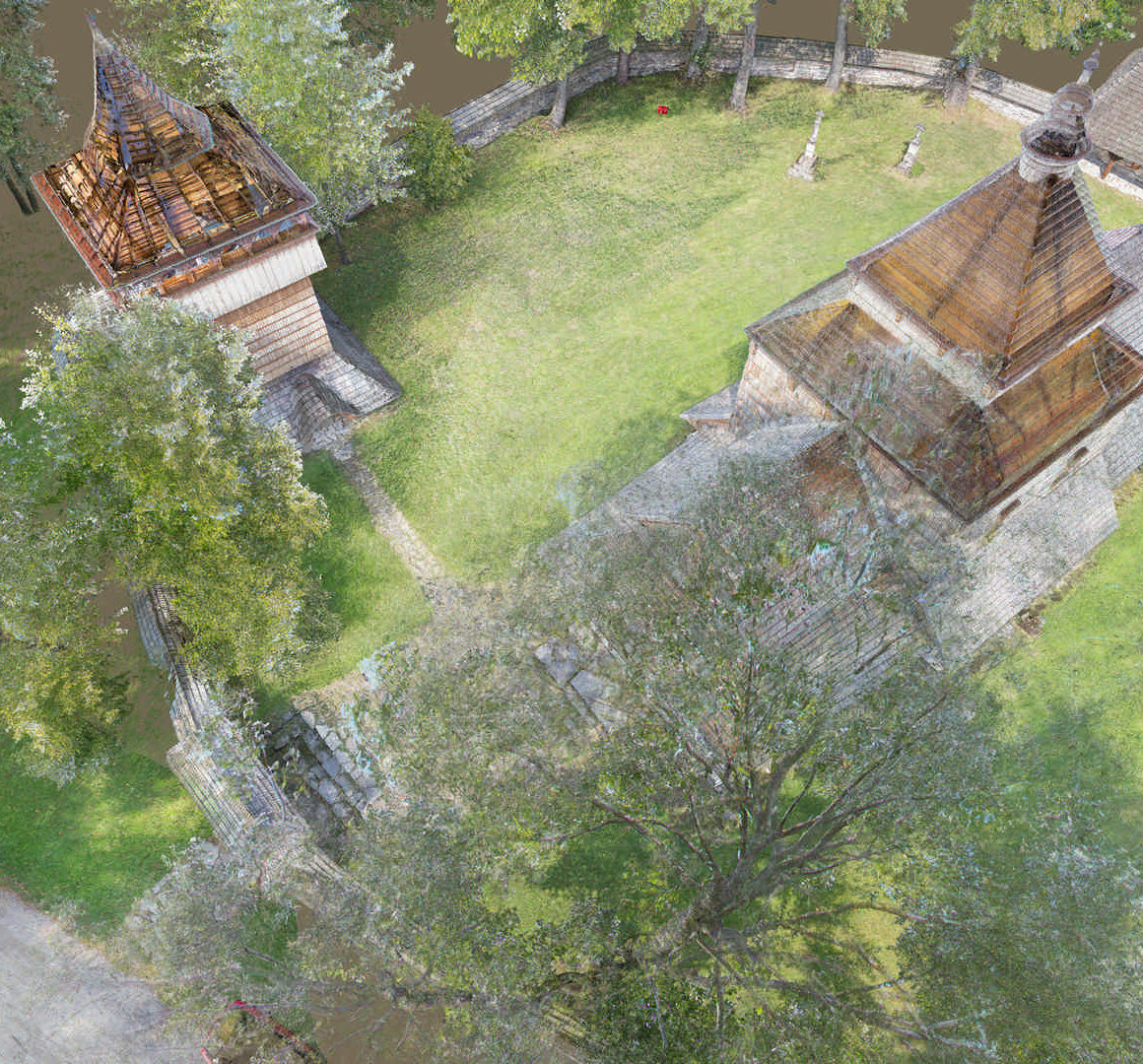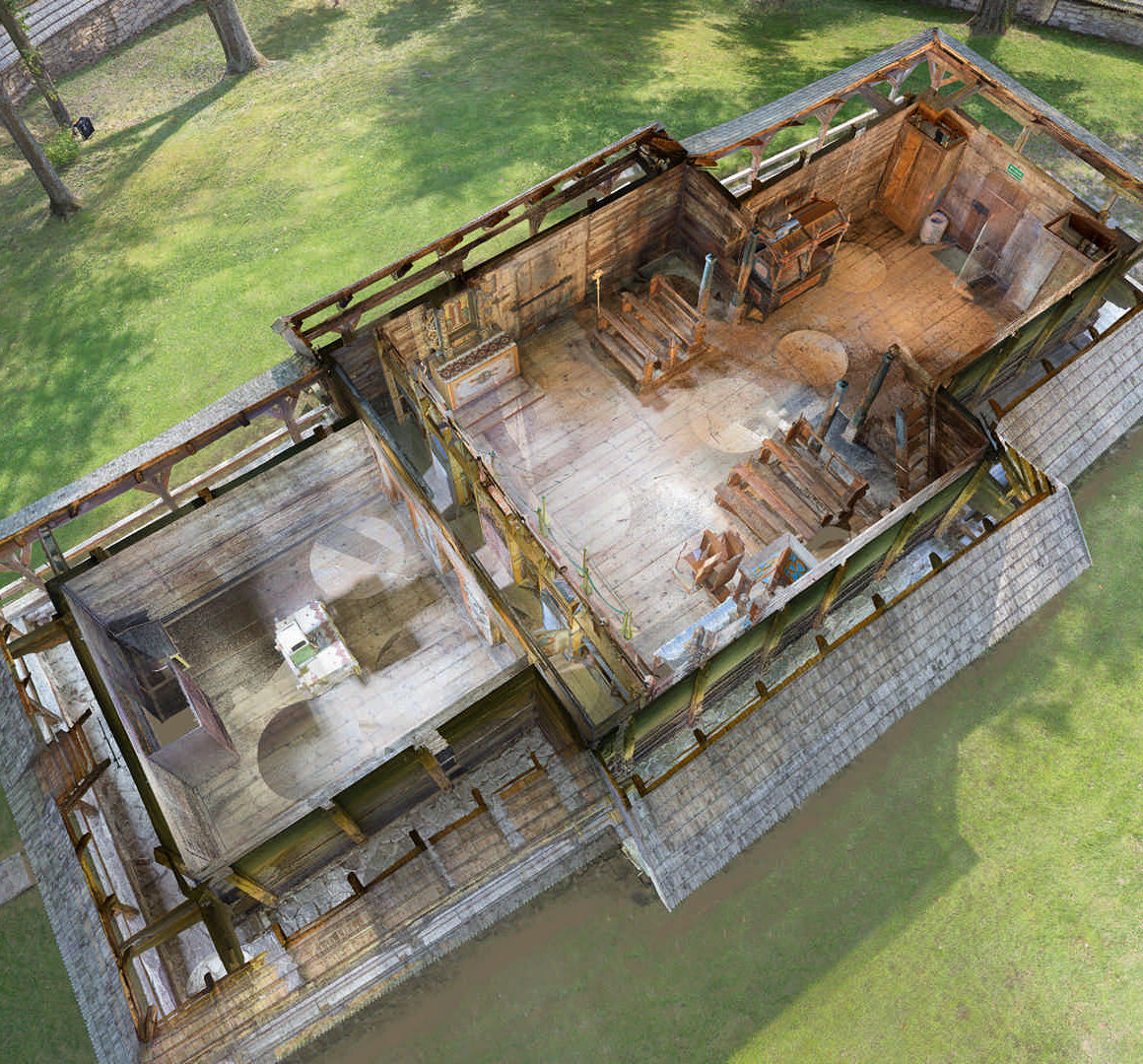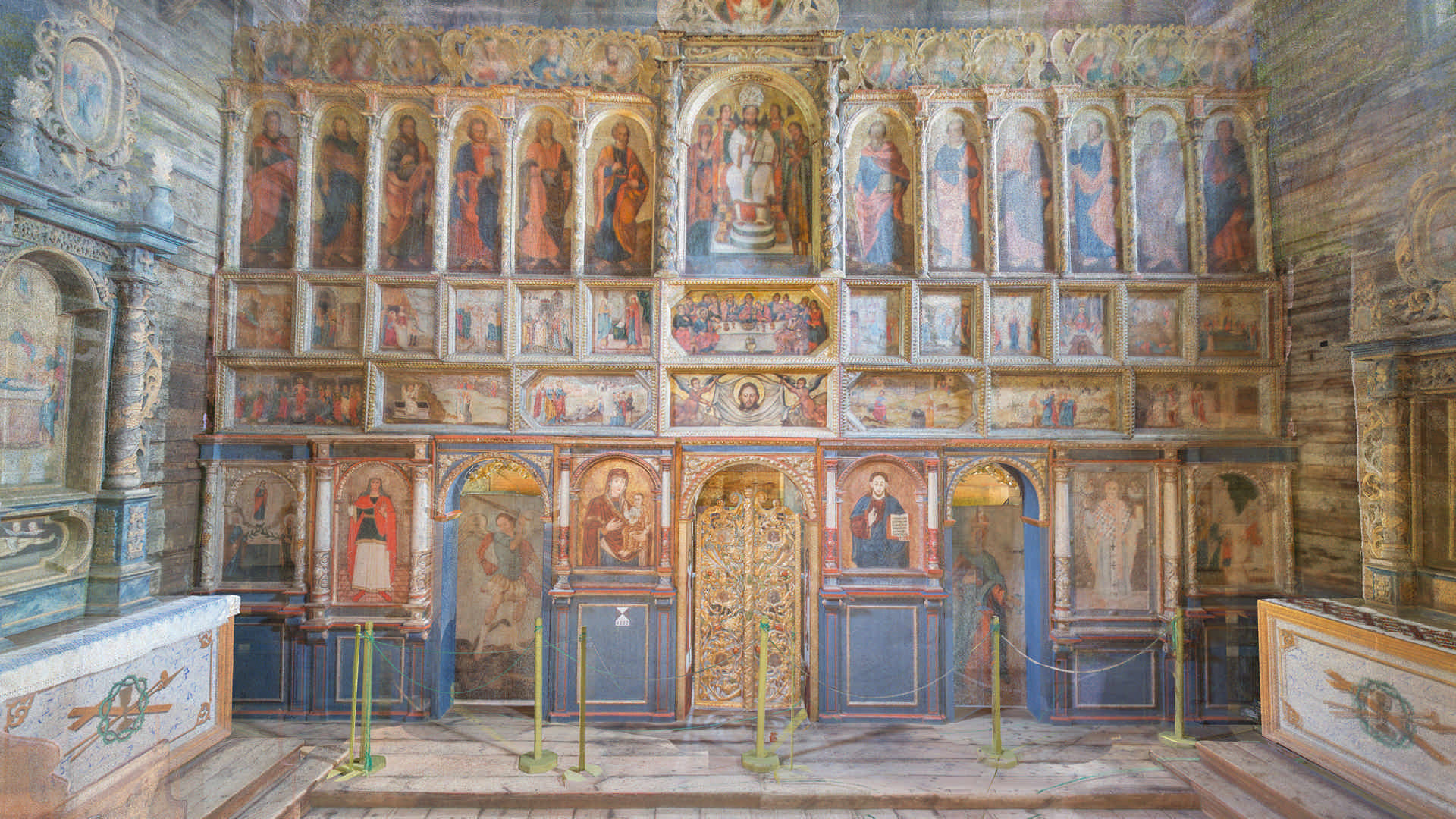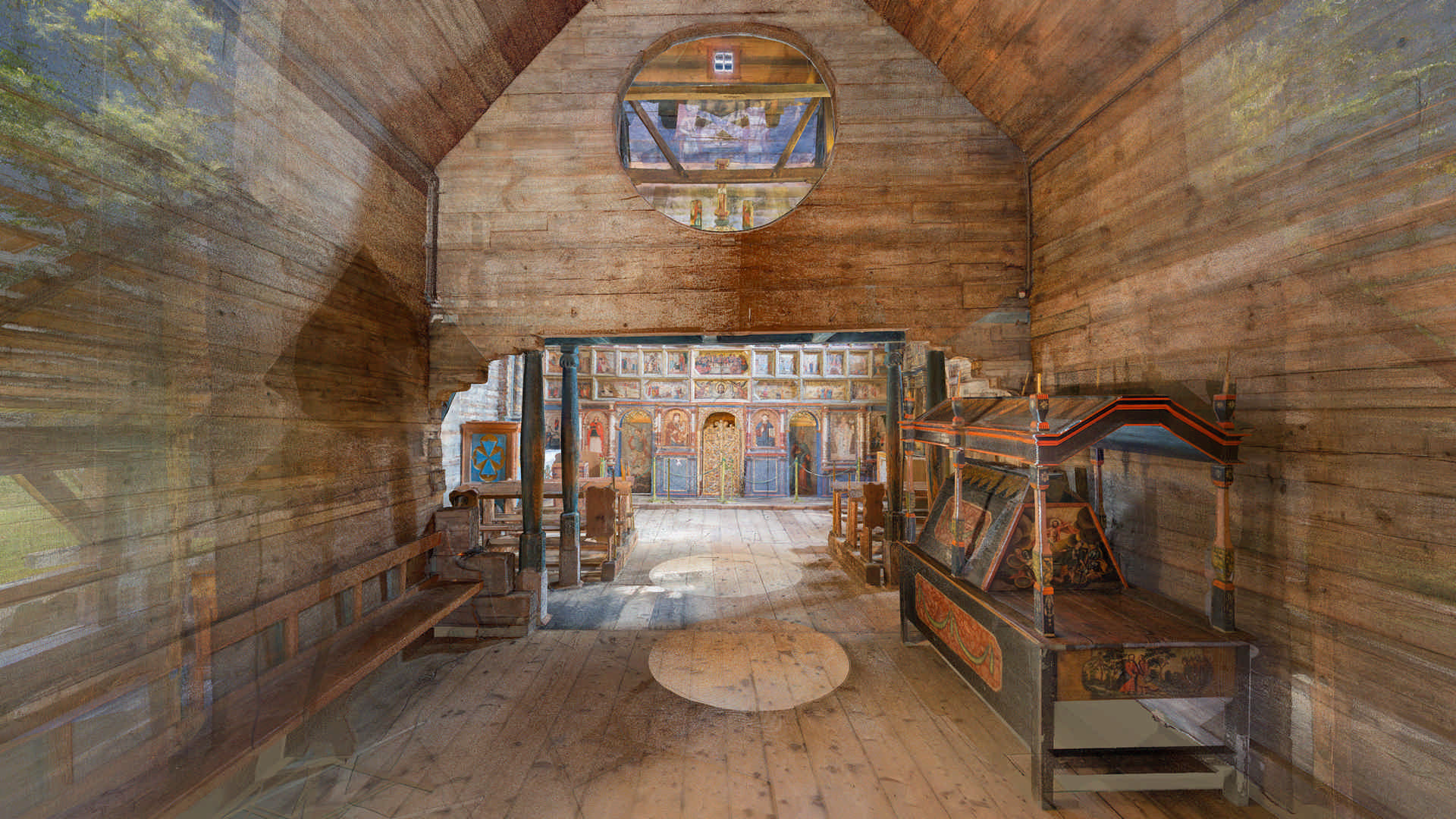Radruż – Orthodox church of St. Paraskevia
The temple comes from the late 16th century. The carpenters used fir and oak wood for its construction. It is a log building. The church consists of three parts erected on a square-like plan: a vestibule, i.e. matroneum, nave, and presbytery. The nave is the largest and highest part. The building is surrounded by soboty, or roofed arcades supported on poles. It is one of the few solutions of this type in the Eastern Roztocze region. The roofs and walls are covered with shingles. We can only find uncovered thick structural beams under the soboty.
The body of the church has a clear symmetry, noticeable in the perspective of its side elevations. The matroneum and presbytery have identical dimensions. Their gable roofs are of the same height. Between them, there is a much larger and higher nave topped with a four-sided dome in the form of a hip roof with one offset.
Just below the roofline of the matroneum and the presbytery is where the expansive roofs of soboty start.
The limited number of small windows highlight the austere impression of the building. There is only one window in the northern wall of the nave, and two in the southern wall. The eastern wall of the presbytery receives some daylight through one extremely small window.
The body of the church resembles a defensive building. In the past centuries, it gave shelter to the faithful during numerous Tatar invasions. The building and the lofty bell tower standing to the left of the entrance are surrounded by a solid stone wall from the 19th century. Apart from its basic signaling function, the belfry could also serve as a watchtower. In its upper part, it is surrounded by a gallery from which it was possible to watch the area and warn of danger in advance.
From the eastern side of the church, at the gate leading to one of the cemeteries, there is a small building. It comes from the 19th century. One of the building’s walls blends with the wall surrounding the area and the remaining part protrudes outside the wall. The building was supposed to be a morgue, but it was never used in this way. For some time, however, it was where sextons would live. In addition, the complex includes several historic tombstones, such as a unique tombstone from the 17th century. Outside the walls, there are two old cemeteries.
Originally, it was an Orthodox church, then – Greek Catholic. Currently, the temple is taken care of by the Kresy Museum in Lubaczów.
Dimensions:
The length of the entire building – 23 meters
The width / length of the matroneum and presbytery – about 5 meters each
The height of the matroneum and presbytery (including vaults) – 7 meters
The width / length of the nave – about 8 and a half meters
The height of the nave with the dome – 15 meters
The Holy Sepulcher in the church in Radruż
The Holy Sepulcher is a mobile piece of the church’s equipment. It is set up inside the temple during Easter. It has the form of a wooden, four-sided table, called mensa. It is topped with a roof supported on six poles. There is a retable placed on the table surface. It has the shape of a lying prism with trapezoidal sides. It takes over half the length and nearly the entire width of the box. The Holy Sepulcher from the church in Radruż dates from 1839. It is made of pine and linden wood. It is two meters high (including the roof), 190 centimeters long, and just over a meter wide.
The building is decorated with painted religious scenes, as well as geometric and floral patterns.
The mensa is 190 centimeters long, 105 centimeters wide, and 83 centimeters high. Its longer sides are painted navy blue, which serves as a background for a centrally located red rectangle with a pattern imitating marble and a suspended fabric. One of the shorter sides of the mensa shows a scene of Jesus being arrested in Gethsemane. Judas is coming up to Christ. Roman soldiers are lurking in the distance. In the background, we can see some green trees.
The retable is 105 centimeters long and 69 centimeters high. The longer sides have a black background with a painted red rectangle with a pattern imitating marble and a suspended fabric. Along the upper edge, there is a triangular leaf pattern. One of the shorter sides of the painting depicts the Resurrection. Jesus in a red cloak is levitating above the grave. We can also see four terrified Roman soldiers running away.
On the opposite, shorter, side of the retable, there is a foundation inscription in Polish and Latin. It contains information about the founders of the Holy Sepulcher and the construction date: June 5, 1839:
“This Holy Sepulcher, under the guidance and with considerable effort of Reverend: X. [or priest] B. Sierociński Paroch r: g: [Greek Rite] of Radruż and the effort of the church administrators, i.e. Grzegorz Stworczyński, Jan Szkolik, and Onufry Kowaliszyna, as well as the devout parishioners of the Radruż village, painted for posterity on June 5, 1839, Hoc sepulcrum Jesu Christi pinxit (hok sepulkrum jezu christi) Andreas de Berezicki”, below, a partially legible inscription in Polish: “Founders of the material for this grave: Onufry Mela … Filip .. rzeczny and … of the grave Jan Mazurkiewicz.”.
The small roof is supported by six columns – three on each long side. They are carved decoratively. They are also decorated with small painted white flowers.
The edges of the small roof are painted in navy blue. They are decorated with red cornices. There are six candle holders above the edge of the small roof. They are located exactly above the points where the beams touch the small gable roof. Against the navy blue background, we can see a triangular leaf motif.
The Holy Sepulcher used to be displayed during Easter. On Good Friday, it was covered with a cloth bearing an image of the body of Christ, the so-called Epitaphios (Plashchanitsa). The retable was displayed on Easter Sunday.
Video:








